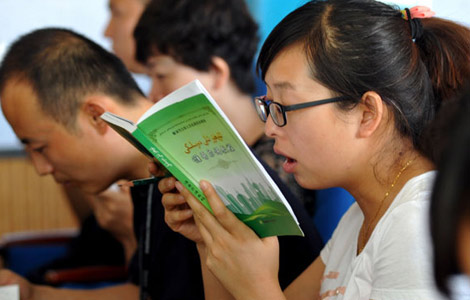County linked at last with outside world
Updated: 2013-08-07 07:40
By Wang Huazhong, Liu Xiangrui and Daqiong (China Daily)
|
|||||||||||
| More high-resolution photos related to the story |
County specialties, such as bamboo handiwork, dried chili peppers and dyed goods were shipped to the station, or "swap shop" as the locals called it, ready to be exchanged for necessities such as cloth, salt and ironware.
"It (the station) had such a variety of soft cloth that I'd never seen before; black, blue, white and yellow," said Sangye Dorje.
"The people of Medog owned just a single set of clothes, which they wore during the day and used as bedclothes at night. Some locals worked for a month at the tailor's workshop to afford a set of clothes, but those who didn't sometimes wore animal skins" he explained.
The lowland sections of the Monkey Pass were plagued by leeches and malaria-carrying mosquitoes, and the trail was constantly damaged by mudslides and collapses.
Meanwhile, avalanches were frequent on highland sections of the route, especially on Doxong La Mountain. It's one of a number of peaks on the pass that the locals say are made up of the piled bones of the thousands who have died attempting to cross them.
"My father was an optimist. He thought that because the horse pass was there, life had already improved greatly," said Sangye Dorje.
No longer isolated
Starting in 1975, construction teams and soldiers began building a frontier defense road to link Zhamog township in Bomi county with Medog. The road was the precursor of the Zhamog-Medog motorway, but when it had extended 108 km from Zhamog, the project was terminated in 1981 after the central government ordered Han officials to be transferred from Tibet.
According to Li Wei, head of the Medog traffic bureau, the building of the Zhamog-Medog motorway returned to the government agenda in 1988 as part of China's reform and opening-up policy.
Finally, in 1993, the first vehicle, a Chinese-made truck, drove into Medog, indicating that the "elusive lotus" was no longer isolated. Curiously, the truck never left and was abandoned at the northeastern corner of the county's Lotus Square.
The arrival of the truck was a one-off event, though, and in the decade that followed no other vehicles made their way into Medog because extreme weather conditions and geological hazards made the road impassable, according to local officials.
Although State and local governments allocated funds to repair the road and the locals participated in the work, the area's unstable geology caused endless problems.
"Experts from the Ministry of Transport, who conducted a survey on the road in recent years, discovered a complex web of geological problems, including unstable mountains, mud and landslides and collapses," said Li.
"The region has very rich waters and gets lots of precipitation, which also causes instability."

Locals continued shipping their goods and the road has been passable, if only seasonally, since 2000 when a transit station, named 80K after its location 80 km from Zhamog township, was established and put into operation.
The station divides the road into two parts. The first section from Zhamog to 80K is only passable from July to September when the heavy snows are either melting or just beginning to fall.
The second section, from 80K to Medog, is closed to traffic from April to November, a period of heavy rains when landslides, mudslides and collapses frequently occur. These natural restrictions mean that goods must be stored at 80K during the summer, awaiting shipment to Medog from November to March.
The situation had not changed by 2008, when the State Council invested 950 million yuan to upgrade the road and bored the Galung La Tunnel.
Now, said Li, the road has made history by being open for more than a year (from April 2012 until now).
"I have to admit that conditions played a large part in the success, which depended on one hand on the hard work and determination of the local people and on the others on favorable weather," said Li.
The road has received annual maintenance subsidies of 3.6 million yuan from the government of the autonomous region since 2007.
Flowering lotus
Like many other farmers in the area, Tsering Tenzin, 61, used to grow radishes, wax gourds, pumpkin, eggplants and red peppers. These were the only vegetables he cultivated until the opening of the Galung La Tunnel road changed his habits.
"It rains a lot here. Vegetable roots rot easily after soaking in the excessive water. Leaves are quickly consumed by bugs, too," he said. "We can coax all kinds of taste and flavors out of a very limited range of vegetables. Whenever the road was blocked, very few people could afford the vegetables that were shipped in on horseback."
The elderly farmer recalled the year 2000, when a landslide blocked the Yarlung Zangbo River, raising the water level by 30 m and destroying all the small bridges and paths.
Related Stories
M-5.2 quake hits Tibet: CENC 2013-08-07 05:24
Development key to address Tibet issues 2013-08-06 20:45
Horse-racing of Shoton Festival in Tibet 2013-08-06 09:22
Foot-and-mouth disease confirmed in Tibet 2013-08-05 21:56
Collapsed bridge in Tibet to be open in Sept 2013-08-05 07:02
Tibet welcomes a campus mountaineering team 2013-08-02 17:15
Today's Top News
China central bank continues liquidity injection
Two more companies recall milk products
Small firms should also think global
NBA courts Sina Corp
Govt to court private capital
EC denies delay in telecoms probes
Snowden obtains formal registration
Japan's new warship draws fire
Hot Topics
Lunar probe , China growth forecasts, Emission rules get tougher, China seen through 'colored lens', International board,
Editor's Picks

|

|

|

|

|

|





